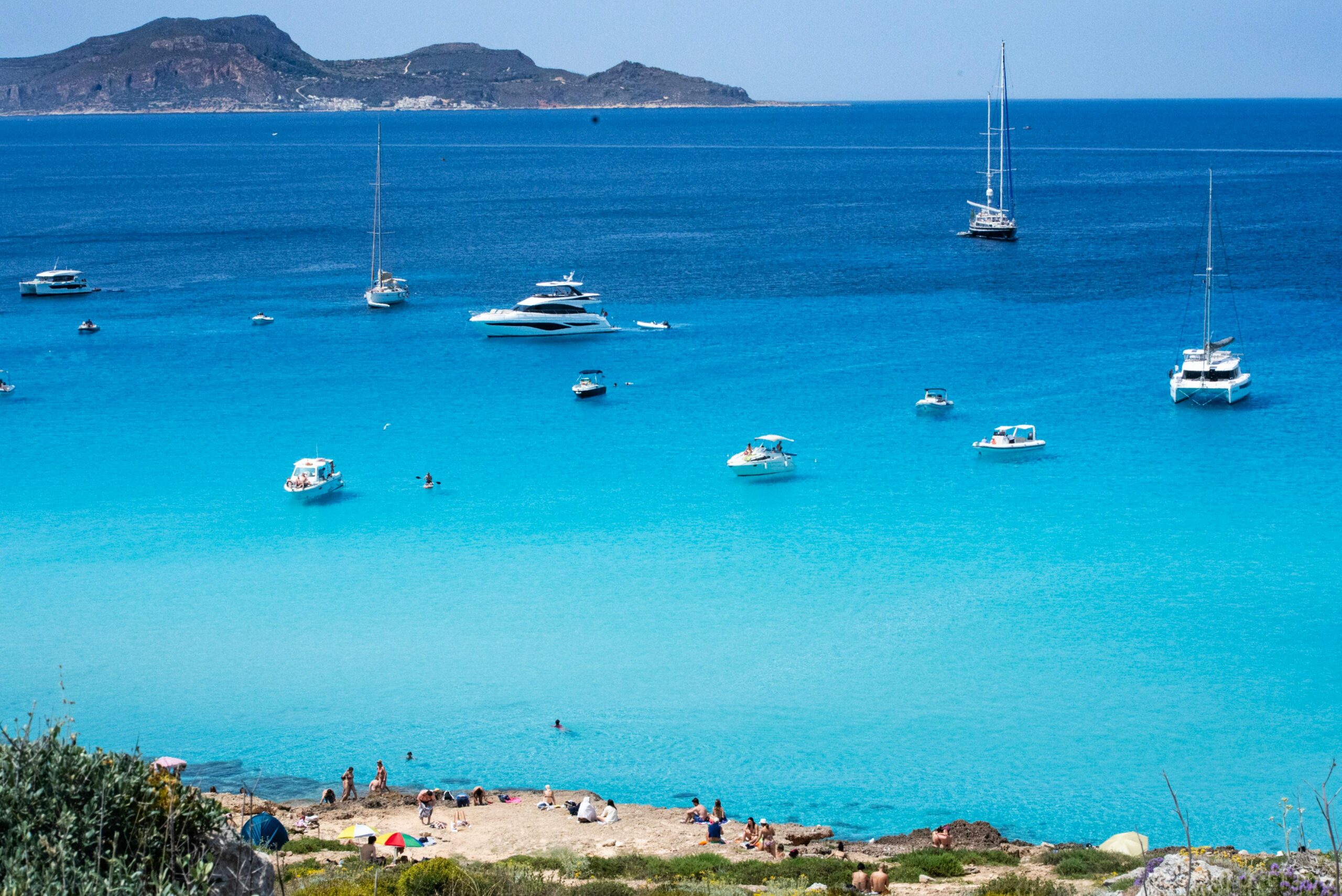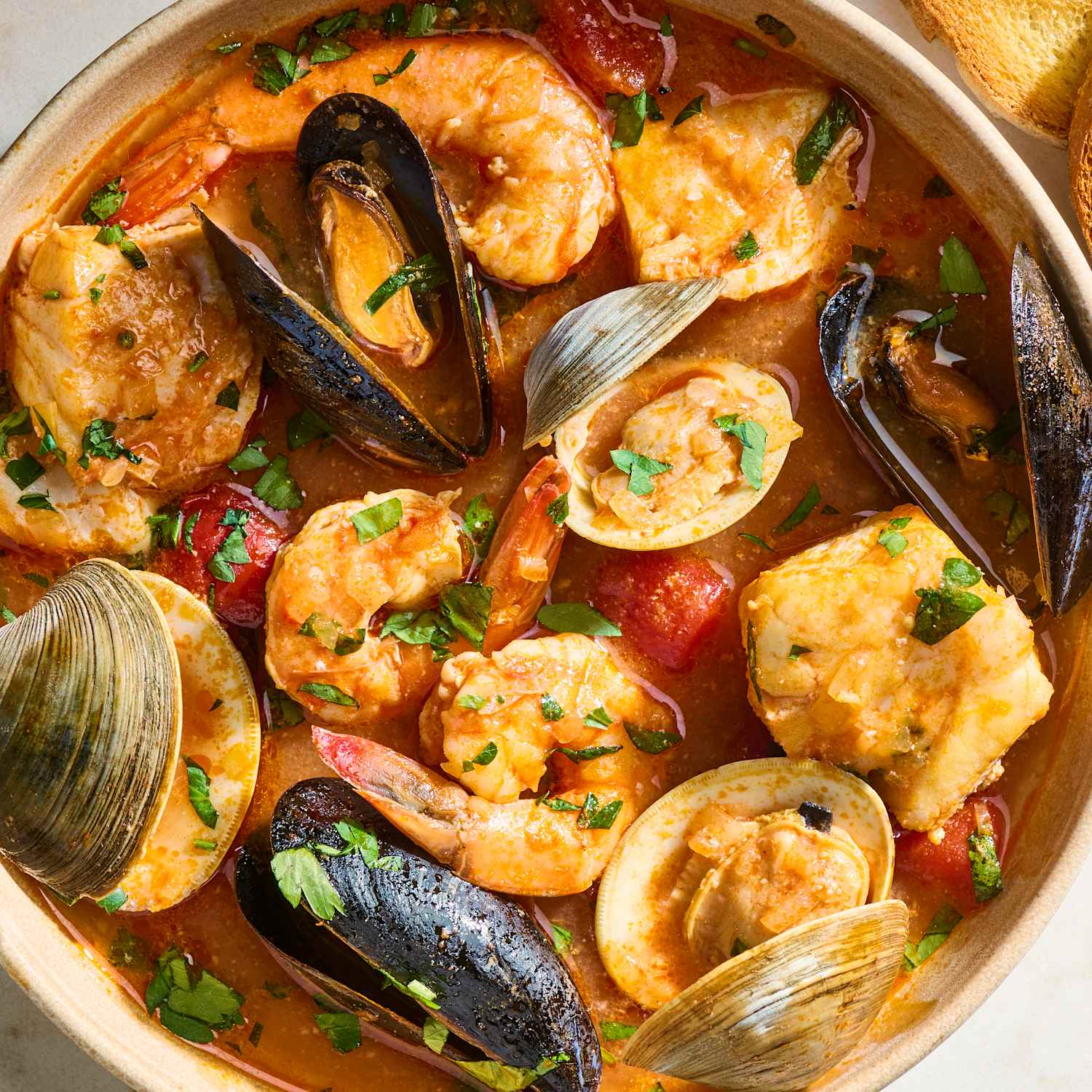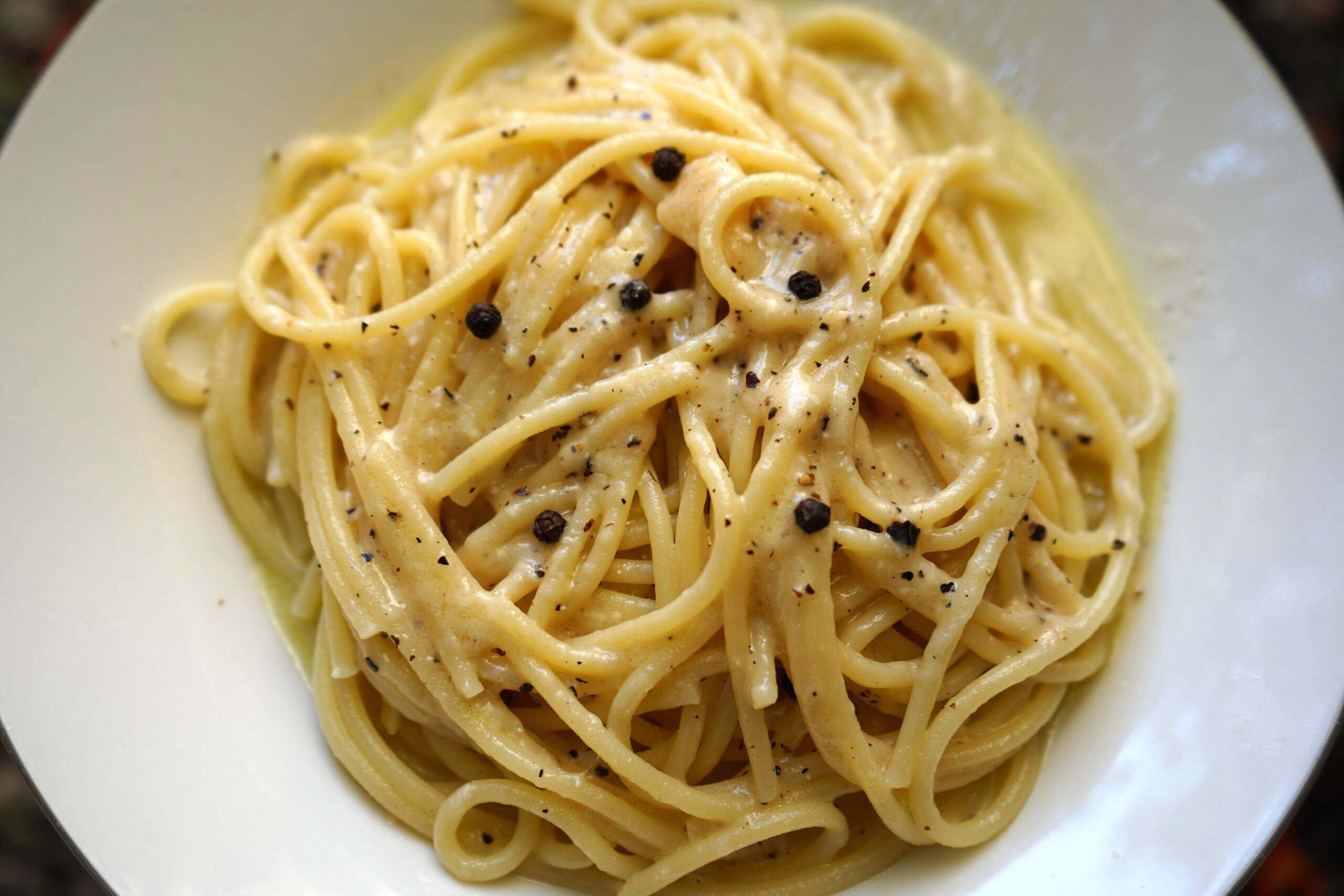Trapani: Where Time Slows on the Edge of Sicily

I spent a week in Trapani, and if Sicily writes love letters, Trapani’s inbox would be overflowing — every line penned in sea salt and sunsets. This little port town on the island’s western edge doesn’t rush; it drifts. Life here moves with the tide: gentle, steady, a little salty, and blissfully unbothered by the idea of a schedule. Watching it, I couldn’t help but think the whole town had signed a pact with slowness.

It felt like another planet — statues standing guard over piazzas, quiet alleys whispering their secrets, bookstores with their doors flung open as if inviting you in. The thick summer humidity coated my skin like a sauna. My hair frizzed, my lips cracked, but I didn’t care. I moved through the city center until I reached the Cathedral of San Lorenzo. Its sandstone façade glowed golden in the late-afternoon light, solid and timeless. And then a rainbow beam of light shot across the church, as if heaven itself decided to photobomb the moment. That’s Trapani: slowing you down just long enough to catch its quiet miracles.
Trapani isn’t a place you “do.” It’s a place you feel. You wander. You linger. You sit by the sea longer than you meant to, because the air smells like salt and jasmine, and for once your to-do list doesn’t stand a chance.
The famous salt flats stretched out like giant mirrors under the Sicilian sun. White mounds glowed in the distance while ancient windmills creaked lazily in the breeze. Salt is still harvested here by hand — patient, steady, intentional. The kind of work that teaches you to slow down and respect time.
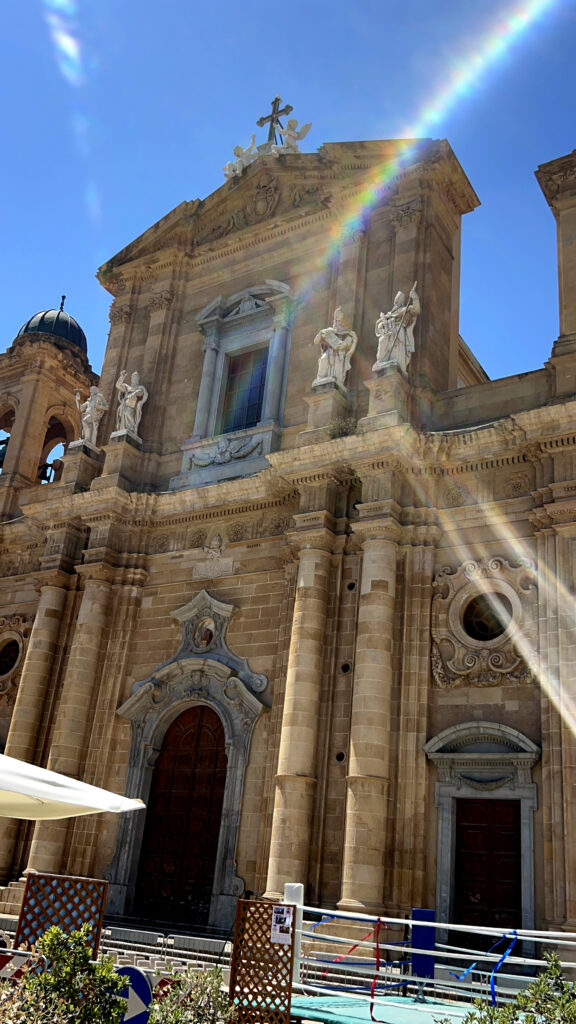
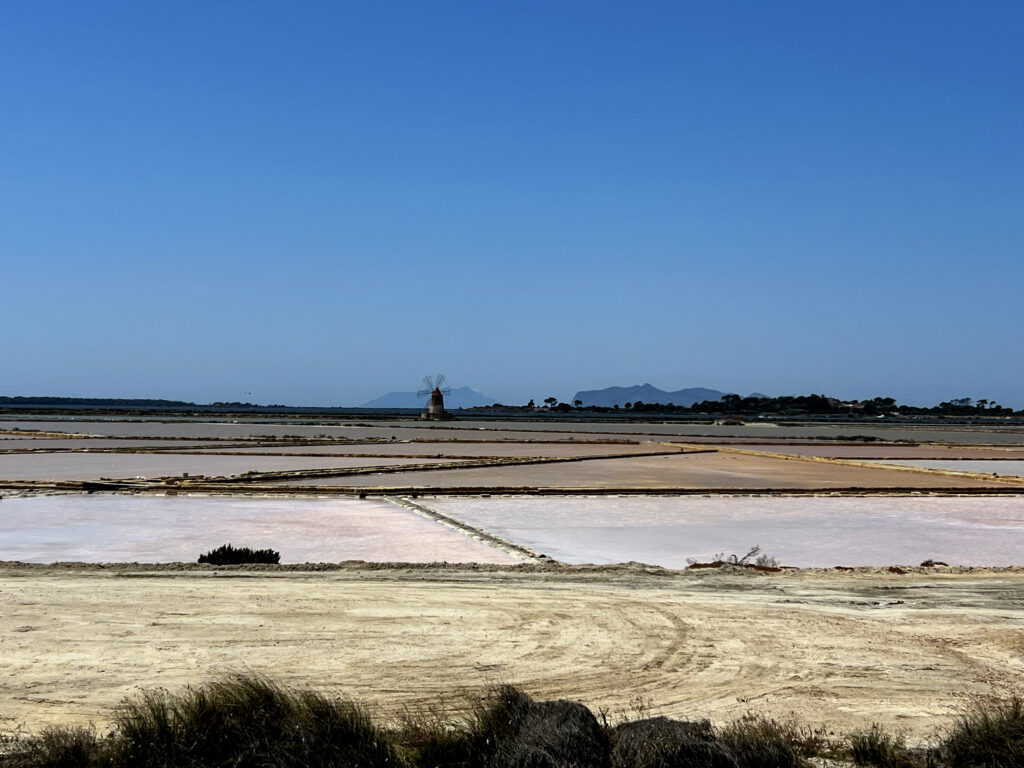
Meals, like the rest of the Mediterranean, aren’t quick. They’re rituals. Lunch slides into the afternoon without apology. Wine glasses never seem to empty, and dessert appears even if you didn’t order it. Here, food is less about eating and more about belonging. I could taste every flavor, every ingredient, as my cheeks burned from smiling and laughing.

This was our last trip before my son leaves for college. We were joined by my cousin from Turin, and somehow ended up meeting the parents of a friend from back in the States. Did I know them well? Not at all. Did that matter? Not one bit. That’s the Italian way. Hospitality flows by association — if you’re even loosely connected, you’re family. One aperitivo turns into two, stories are swapped, translations pieced together like a puzzle.
And then there’s Erice — Trapani’s secret twin perched high above the sea. You climb into the clouds, and everything shifts. The temperature drops, the air turns crisp, and suddenly you’re wrapped in a cool breeze that feels like a relief after Trapani’s warm coastal sun. The cobblestone streets twist like a web, lined with medieval walls, archways, and quiet courtyards. Cats nap in doorways as if they own the place (and honestly, they do). Walking Erice feels like stepping back in time — quiet, shadowy, almost otherworldly. While Trapani hums at sea level, Erice whispers. The silence feels old, sacred, steady, as though every stone has been keeping secrets for centuries.
When evening comes, Trapani’s skies perform in slow motion. The sun doesn’t just dip into the sea; it lingers, stretching pinks and golds across the horizon. From Erice, the view is something else entirely — the coastline of western Sicily sprawled beneath you, fading into lavender as bells chime in the distance.
Just when I thought Trapani had shown me everything, the morning of my departure gifted me one last cherished memory. On the way to the airport, the sky was alive with a thousand wind surfers. Their colorful kites whipped and danced like confetti across the sky — and somehow perfectly in rhythm with Trapani’s slow wind.
Trapani isn’t just a place you see. It’s a pace you feel. You eat slower, you walk slower, you notice more. And when you leave, you carry that rhythm home with you. I don’t know if I’ll ever return, but this much I know: I’m grateful I experienced it. Because Trapani taught me that the best moments aren’t rushed — they’re the ones that unfold slowly, softly, like the tide.
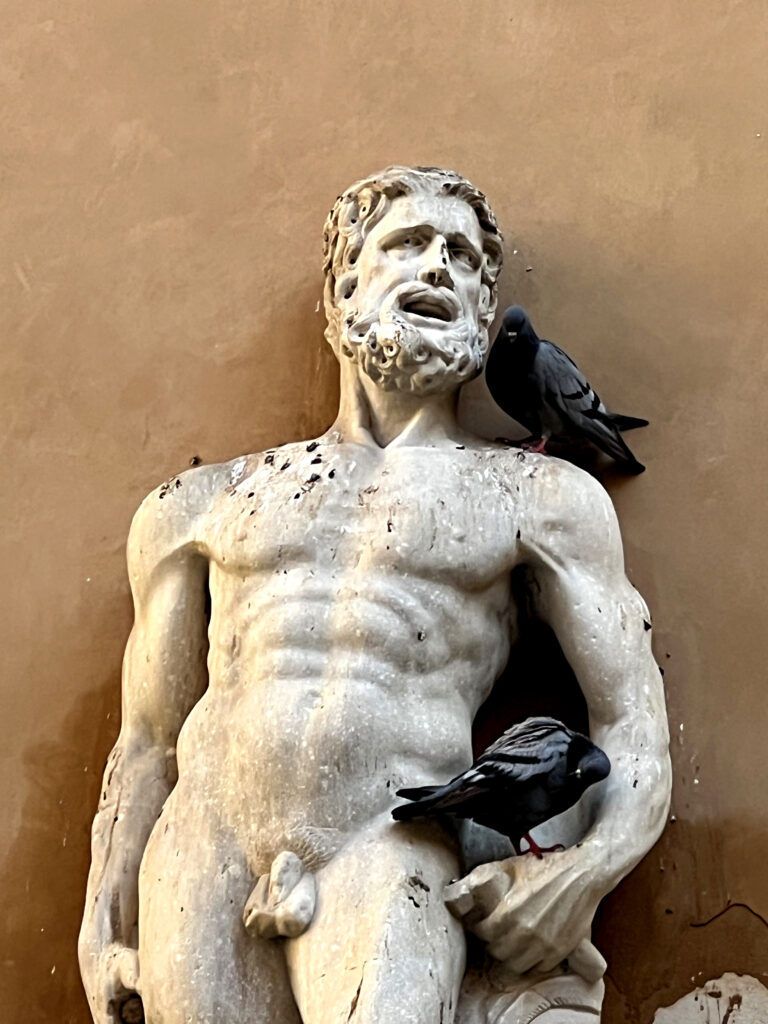
Travel Insights for Trapani
When I think back on Trapani, I realize it’s not just a destination—it’s a mood. And if you’re planning to go, here’s the thing: you can’t “do” Trapani the way guidebooks sometimes push you to “do” a city. You can only enter into its rhythm. These aren’t rules so much as invitations—ways to let Trapani reveal itself to you the way it did for me.
1. Don’t Rush the Salt Flats
The salt flats are famous, yes, but they’re not a quick stop for a photo. Give yourself time to walk along the paths, to stand and listen to the creak of the old windmills, to notice how the water mirrors the sky. Go in late afternoon, when the sun sets low and the flats turn into a giant watercolor painting. And if you can, take the boat tour into the lagoon. There’s something almost meditative about gliding through water that feels endless and still.
2. Wander Without a Map
Trapani’s historic center isn’t huge, but that’s the beauty of it. You don’t need a plan—just start walking. The streets curve and open into piazzas like little surprises. One moment you’ll find a baroque church with a façade glowing gold, the next you’ll stumble on a tiny bookshop with its doors wide open. I made it a point to put away my phone and let the town guide me. It was in those moments—turning a corner into sunlight, or finding a café by accident—that I felt closest to the spirit of the place.
3. Eat Like a Local, Not a Tourist
Meals in Trapani aren’t about speed. Lunch might take three hours, and that’s the point. Order the couscous al pesce—Trapani’s signature dish, where North African influence meets Sicilian seafood. Don’t skip busiate pasta, twisted and chewy, often served with pesto Trapanese made from almonds and tomatoes. And if you see pane cunzato (seasoned bread) on a menu, say yes: it’s humble—bread topped with tomato, anchovy, cheese, and olive oil—but it tastes like the essence of Sicily.
Oh, and about dessert: do yourself a favor and try the cassatelle, little fried pastries filled with sweet ricotta and chocolate. They taste like childhood wrapped in dough.
4. Time Your Aperitivo
Aperitivo in Trapani isn’t just a drink before dinner—it’s a way of extending the day. Find a bar along the seafront promenade around sunset. Order a spritz or a glass of local white wine (Grillo or Catarratto), and let the colors of the sky shift while the sea air curls through your hair. If you’re lucky, you’ll end up chatting with locals, and one drink will turn into three as small plates keep arriving at your table.
5. Make the Climb to Erice
If Trapani hums, Erice whispers. Take the cable car up from Trapani to Erice—it’s an experience in itself, watching the town shrink as you rise into the clouds. Once there, slow your pace even more. The cobblestone streets are steep and winding, and they deserve your attention. Visit the Chiesa Madre, stop for genovesi (buttery pastries filled with cream), and don’t forget to look out over the coast. From up there, Trapani looks like a dream you’re not quite ready to wake from.
6. Take the Ferries Out
Trapani is the gateway to the Egadi Islands: Favignana, Levanzo, and Marettimo. Each has its own rhythm. Favignana is perfect for a day of biking between hidden coves. Levanzo feels like time forgot it, small and serene. Marettimo is wild, with caves and hiking trails that reward you with sea views that belong on a postcard. Even if you only have a day, hop on a ferry—you’ll see the coast from the water, and it’ll give you a whole new perspective on where you’ve been standing.
7. Stay Central, Stay Simple
Luxury hotels exist, but part of Trapani’s charm is in staying somewhere that feels woven into the town. Look for a small B&B in the historic center, where balconies open onto narrow streets and laundry flutters overhead. Waking up to the smell of espresso drifting in from the bar downstairs is worth more than any infinity pool.
8. Accept That Things Close
In Trapani, the afternoon belongs to rest. Shops close, shutters drop, and the streets fall into a kind of hush. Don’t fight it. Use the time to nap, to read, to sit by the sea with a gelato. This rhythm isn’t laziness—it’s balance. And if you lean into it, you’ll come home with a deeper understanding of how to pace your own life.
9. Learn the Art of “Family by Association”
One of my favorite surprises in Trapani was how quickly strangers became friends. Hospitality here runs on connection: if you’re a friend of a friend—or even a cousin of someone who knows someone—you’re in. Be open to invitations. Say yes to the aperitivo that turns into dinner, or the dinner that turns into a midnight walk. Those are the memories you’ll carry home long after your suitcase is unpacked.
10. Leave Room for Surprise
The best parts of Trapani are the ones you can’t plan: a rainbow beam of light across a cathedral, a cat napping in the doorway of a medieval alley, a sky filled with wind surfers on the morning you leave. The trick isn’t to schedule them—it’s to leave enough space in your trip for them to happen.
Foods Trapani is Known For
Couscous al Pesce
If Trapani has one dish that defines it, this is it. Couscous might make you think of North Africa, and that’s exactly the point — Trapani’s history is a blend of cultures carried across the sea. The couscous here is fluffy, almost cloudlike, and it soaks up a rich fish broth infused with saffron, garlic, and the catch of the day. It’s not a meal you rush. It arrives at the table in steaming bowls, often meant to be shared, and it feels less like a dish and more like a story told through spices.
Busiate Pasta
This spiral-shaped pasta looks handmade even when it isn’t — twisted around a rod to create its signature curl. In Trapani, busiate is more than just pasta; it’s a canvas. You’ll see it tangled in seafood sauces or tossed with pesto alla Trapanese. The texture makes it perfect for holding on to sauce, so every bite feels generous. Eating busiate in Trapani is like tasting the town itself: humble, comforting, yet a little surprising.
Pesto alla Trapanese
This is pesto with a Trapani accent. Instead of pine nuts, almonds take the stage, blended with fresh tomatoes, garlic, and basil. The result is sun-soaked and slightly sweet, a sauce that feels lighter than Genoa’s green pesto but just as unforgettable. Pair it with busiate, and you’ve got one of Sicily’s most iconic combinations.
Pane Cunzato
Translated, it means “seasoned bread,” but don’t let the simplicity fool you. Thick slices of bread are loaded with tomato, anchovies, cheese, oregano, and olive oil until it becomes a meal in itself. Pane cunzato is picnic food, beach food, lazy afternoon food. It’s a reminder that in Sicily, you don’t need a complicated recipe to create something memorable.
Tuna (Tonno)
Trapani has lived on the sea for centuries, and tuna is its heartbeat. You’ll find it grilled, seared, preserved in jars of olive oil, or folded into pasta. The old tuna fisheries — tonnare — are part of the coastline’s history, and even today, tuna remains central to Trapani’s identity. A plate of fresh tuna here tastes like the sea itself: bold, rich, unpretentious.
Gamberi Rossi di Mazara
A short drive south of Trapani lies Mazara del Vallo, home to the famous red shrimp. These aren’t just any shrimp — their bright scarlet color and sweet, delicate flavor make them some of the most prized in Italy. Often served raw with just a drizzle of olive oil and lemon, they’re proof that sometimes the simplest preparation is the most luxurious.
Arancine
Though arancine (or arancini, depending on where you are in Sicily) can be found across the island, Trapani has its own love affair with these fried rice balls. Stuffed with ragù, cheese, or peas, they’re golden and crisp on the outside, soft and savory inside. Grab one from a street vendor and eat it while walking the promenade — it’s comfort food disguised as a snack.
Panelle
If arancine are indulgent, panelle are humble. Made from chickpea flour, fried into thin fritters, and often tucked into bread, panelle are Trapani’s answer to fast food. Bite into one, and you’ll understand why locals keep coming back: it’s crispy, nutty, and deeply satisfying in its simplicity.
Cassatelle di Ricotta
Trapani loves its sweets, and cassatelle are a local favorite. Imagine a pastry shaped like a half-moon, fried until golden, and filled with sweet ricotta and chocolate chips. Served warm, the filling melts just slightly, creating a bite that’s equal parts crispy, creamy, and decadent. It’s the kind of dessert that lingers in your memory long after the powdered sugar has dusted your shirt.
Genovesi Ericine
In Erice, high above Trapani, the signature treat is the genovese. A soft, buttery pastry filled with custard cream and dusted with powdered sugar, it’s best eaten fresh out of the oven. I still remember sitting on a quiet stone step in Erice, holding a warm genovese and thinking it was the perfect companion for the cool mountain air.
Cannoli Siciliani
Cannoli are Sicily’s most famous export, and Trapani is no exception. The shells are fried until shatteringly crisp, then filled with sweetened ricotta, sometimes studded with candied fruit or pistachios. They’re rich, they’re messy, and they’re worth every bite.
Granita al Limone
On hot Trapani mornings, nothing feels more refreshing than granita al limone. Think of it as Sicily’s version of shaved ice — but finer, silkier, more intense. Paired with a soft brioche bun, it’s technically breakfast, but really it’s just joy in a bowl.
Marsala Wine
Just a short drive from Trapani, Marsala gives its name to the fortified wine that’s been produced there since the 18th century. It’s sweet, amber-colored, and often used in desserts or sauces, but sipping it after dinner in Trapani feels like toasting the sea itself.
Trapani is the kind of place that lingers long after you leave, not because you checked sights off a list, but because it slows you down enough to notice what matters. It’s in the quiet of Erice’s stone streets, the shimmer of salt flats at sunset, the laughter around a table where couscous al pesce or busiate pesto are shared without hurry. It’s a rhythm — softer, steadier — that seeps into you with every bite, every stroll, every salty breeze. I carried that rhythm home with me, tucked between photographs and memories, a reminder that life’s richest moments aren’t found in rushing, but in savoring — like Trapani itself, a place best tasted slowly.

